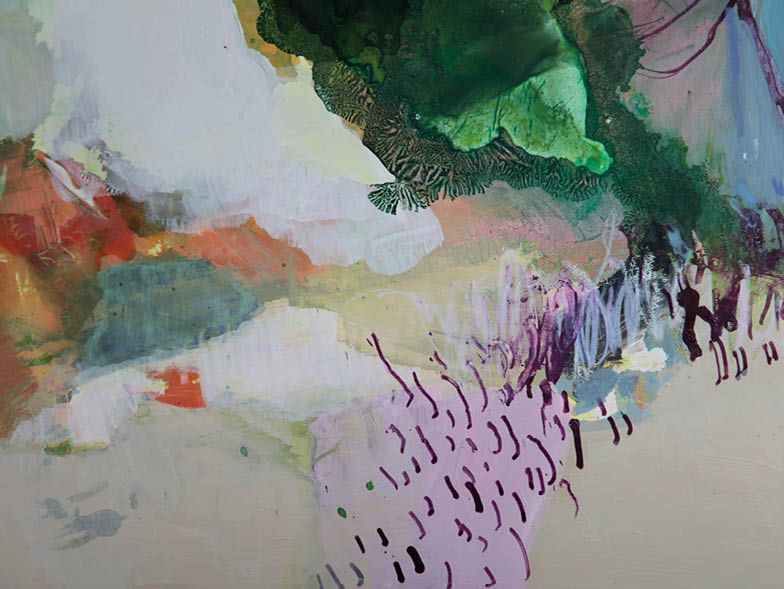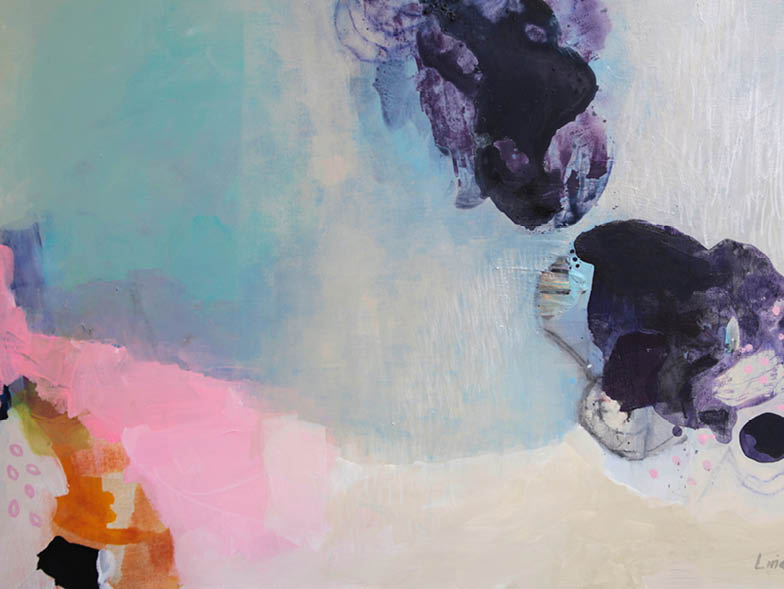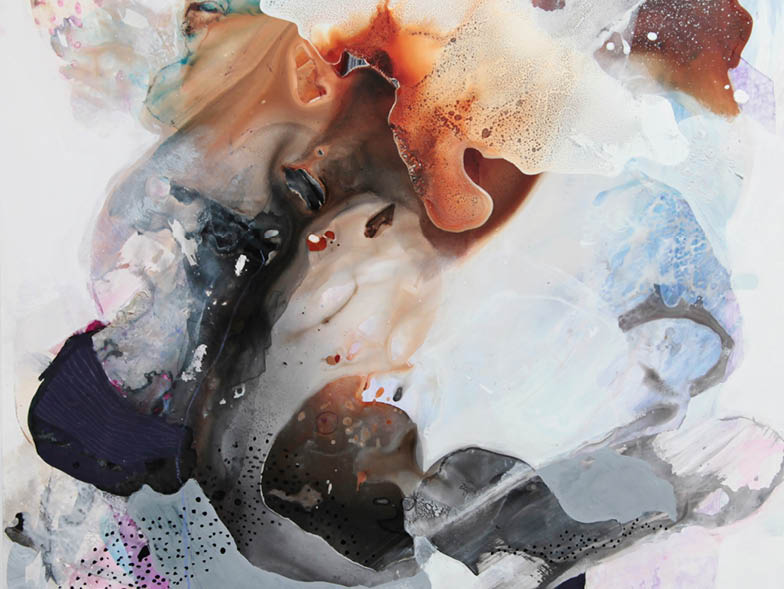An Artistic Balancing Act
Abstract painter Lina Alattar has spent her life seeking balance, from living in various countries as a child to weighing a corporate career versus an artistic career as an adult. This is reflected in her artwork, which blends acrylic and ink, and elements of risk and control, to achieve a wonderful symmetry.

Have you always wanted to be an artist? Were you influenced by others?
As a child, while playing with colors, Play-Doh, or blocks, I would lose myself for hours creating things. I remember at the age of four wanting to be an artist. It was less of a choice and more like an urge that continued throughout my life. And, as much as society and upbringing have tried to influence me otherwise, I had to honor that part of me that knew from an early age what’s it’s like to
love something.
You lived on three continents by the age of twelve. Where did you live during that time? How have your various experiences with different cultures influenced your life, your perspective, and your artwork?
I was born in Iraq. We left when I was a child, and we lived in Germany for a few years before moving to the US. I lived in California and then went to college in Tennessee. My sister moved to DC to attend Georgetown University; I fell in love with the area and decided to settle here in Virginia.
Experiencing a variety of cultures heightened my senses, making me aware of how we express ourselves in terms of music, food, literature, and architecture. Art was my entry point into all of this. This variety also enriched my perceptions—and, like many artists, everything I experience finds its way into my art.

What or who drew you to abstraction? Which abstract artists are your role models?
My love for abstraction started in college, where I often shared semantic discussions on abstract art with my professors. After college, during an art study program in Italy, I was exposed to painters who encouraged an experimental approach to painting. I quickly became attracted to what felt like a nonconformist way of making art. It opened up so many possibilities for self-expression. My very first influences included Joan Mitchell, Cy Twombly, and Richard Diebenkorn. I became attracted to their subjective experiences.
From your experience, what are the pros and cons of being an art director versus a full-time artist? What made you decide to make the switch?
Art and design serve different functions. As an art director, you’re communicating a practical and commercial message. As an artist, you’re utilizing the creative expression. It’s less about economics and more about this rich and creative thinking that brings meaning and connections between the viewer and the artwork.
Although I still loved design, I had missed the tactile experience of making art. I wanted content and meaning in my work, which is why I made the switch.
Has your career transition been a smooth one?
It has been a work in progress. There is no blueprint for a career in art, and I’ve had to figure it out day by day. This lack of predictability also keeps things exciting and open, both in my work and in my career.

What is your process for creating a piece of art? How long does it take? What does the process itself mean to you?
I work on multiple paintings at a time, usually five to eight pieces. I always start with a specific color palette in mind. This is pretty much the only part that’s preplanned. Everything else is process based; I’m always looking at and responding to the marks as I go along.
I paint in three- to four-hour intervals, when I get centered and focus on the work. I have to be in a place of clarity and openness so that the creative process comes through. It’s during this space that I welcome the accidental, the uncertainty, and the mess. Then I shift gears and try to make sense of what’s in front of me—adding, subtracting, and adjusting. It’s where the integration happens. It’s a very intuitive and personal process.
What are you most meticulous about as an artist?
Certainly not my process. Being meticulous is not in my vocabulary. It kills creative thinking.
When you enter your studio, how much do you control the brush, and how much does it control you?
I try to have clarity and openness to trust this process as it unfolds. The more I control the brush, the harder the process is. Interestingly, my 2017 series, At the Seams, explores the notions of risk and control. The in-between places are what intrigue me.
Tell us more about At the Seams:
The search for balance is fundamental in my work. Each piece here starts with the notions of risk juxtaposed with calculated marks. Broad, spontaneous color fields of thick acrylics are confronted with deliberate and intricate markings of the ink’s fluidity, so that the visual order is constantly shifting as I welcome the arbitrary while making sure to stay conscious of its counterpart. Hence, the name of the series.
Overall, I find that this process mirrors the duality of human nature: how deliberate are we in what we invite in versus what we allow to unfold? It results in a complex yet intuitive symmetry, where both the unexpected and the intentional live in a delicate balance—both in our lives and in art.

Since you stress the importance of balance in your work, what does it mean to you personally?
It gives me the understanding that life is inherently unpredictable. This mind-set helps me to be more playful during the painting process. I’ve come to realize that inviting the ambitious and the unbalanced aspects of our lives allows for more possibilities. Our eyes become more intrigued as we look at the work. Making art certainly stabilizes my life; it’s a great anchor.
You mentioned that you work with both acrylics and ink. What does each bring to your canvas?
I’m always playing with these two qualities: the lyrical application of the ink along with the opaque qualities of the acrylics. The contrast of their characteristics intrigues me.
Do any paintings stand out as ones you’re especially proud of?
Balance Beam and Without Intensions. In both, I was able to achieve this fine balance between uncontrolled yet deliberate.
What do you hope your audience experiences when observing your works?
No matter how you cast it, viewing art gives us an aesthetic experience. It taps into the very things that make us human. I hope my work leads the audience to a richer inner world and leaves them with a sense of wonder.
What do you enjoy doing when you’re not painting?
I enjoy swimming on a regular basis. Time with my kids and family is always a priority. Also, I make frequent visits to galleries, museums, concert halls, and art talks.
As a frequenter of the arts, what role do you think they play in the human condition?
I believe the arts are a mirror that reveals our truth. The reason we resonate with a certain piece of music, or art, or poetry, for example, is because it transcends the everyday and leads you back to yourself. It adds meaning to an otherwise banal world.
What would your life be like today if you weren’t involved in art?
I feel very grateful to be doing something I love, and really can’t imagine what my life would be like if I was doing something else.
For more info, visit linaalattar.com.






















